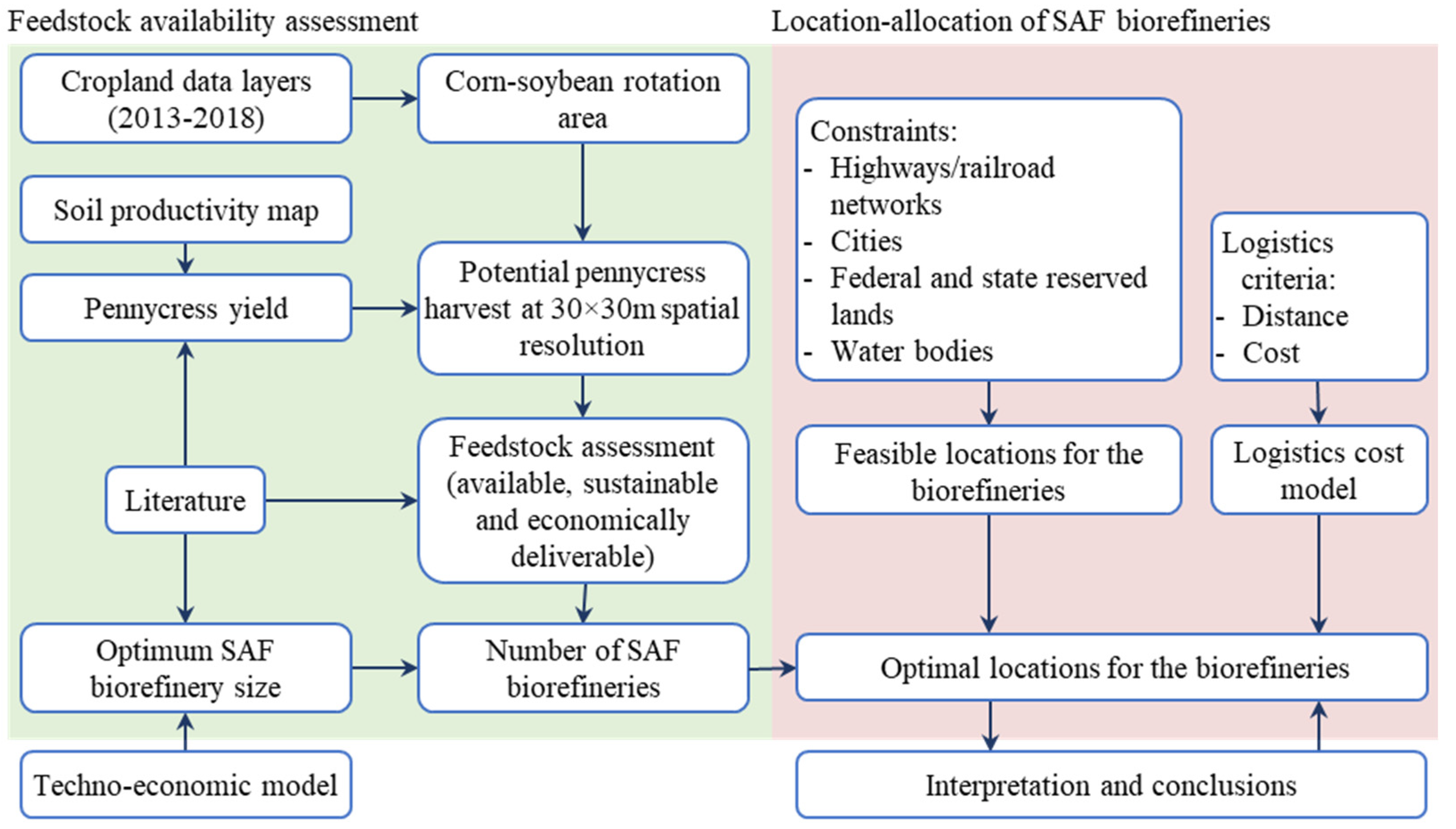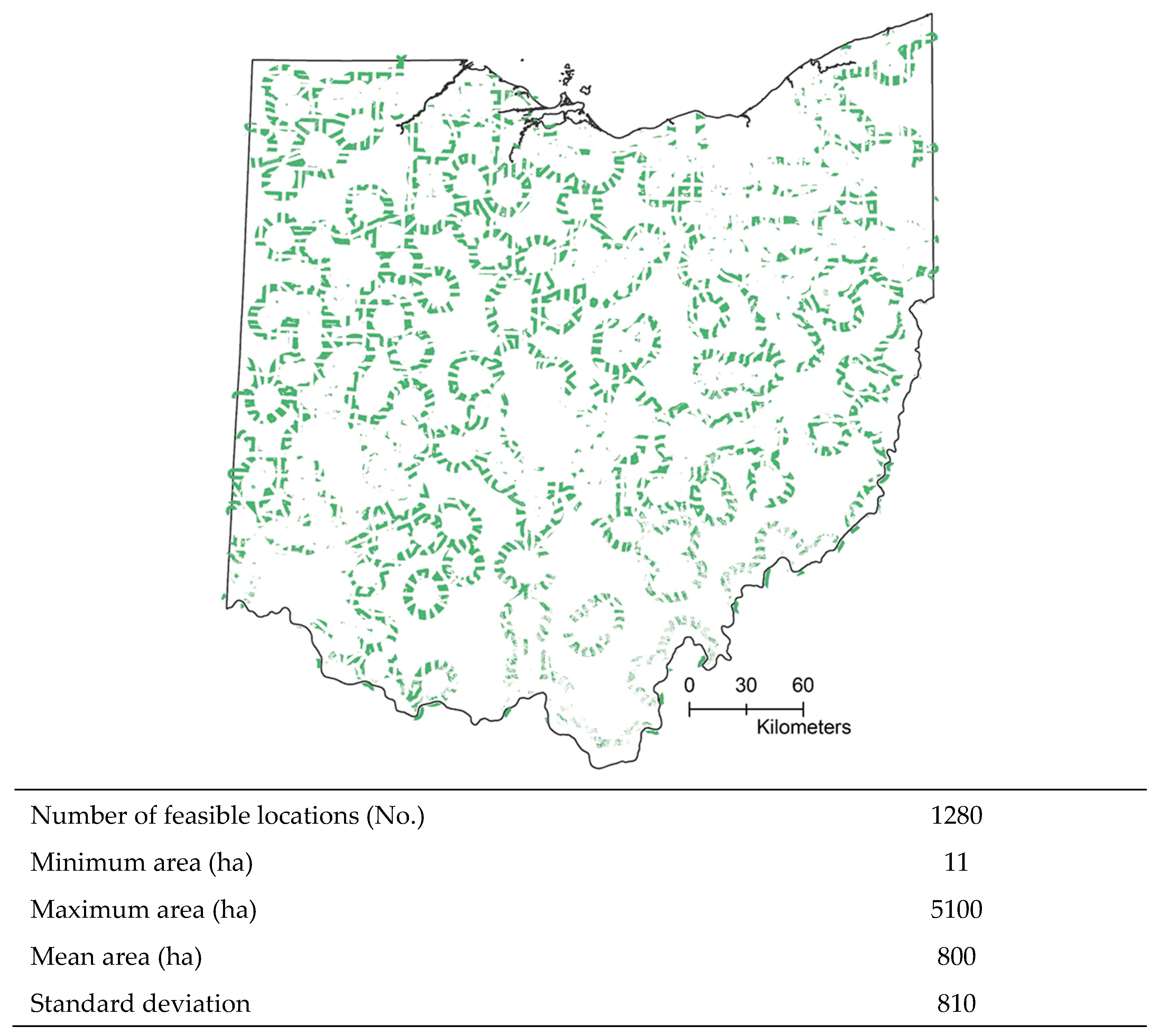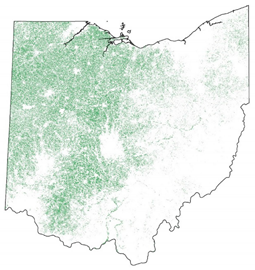Assessment of Potential Pennycress Availability and Suitable Sites for Sustainable Aviation Fuel Refineries in Ohio
Abstract
1. Introduction
2. Materials and Methods
2.1. System Overview
2.2. Data Collection
2.3. Pennycress Resources’ Assessment
2.4. Location-Allocation of SAF Biorefineries
2.4.1. Identifying the Feasible Biorefinery Locations
2.4.2. Identifying the Optimum Locations of SAF Biorefineries
3. Results
3.1. Pennycress Production Potential in Ohio
3.2. Location-Allocation of SAF Biorefineries
4. Conclusions
Supplementary Materials
Author Contributions
Funding
Institutional Review Board Statement
Informed Consent Statement
Data Availability Statement
Acknowledgments
Conflicts of Interest
References
- O’Connell, A.; Kousoulidou, M.; Lonza, L.; Weindorf, W. Considerations on GHG Emissions and Energy Balances of Promising Aviation Biofuel Pathways. Renew. Sustain. Energy Rev. 2019, 101, 504–515. [Google Scholar] [CrossRef]
- Kandaramath Hari, T.; Yaakob, Z.; Binitha, N.N. Aviation Biofuel from Renewable Resources: Routes, Opportunities and Challenges. Renew. Sustain. Energy Rev. 2015, 42, 1234–1244. [Google Scholar] [CrossRef]
- Liu, G.; Yan, B.; Chen, G. Technical Review on Jet Fuel Production. Renew. Sustain. Energy Rev. 2013, 25, 59–70. [Google Scholar] [CrossRef]
- Elgowainy, A.; Han, J.; Wang, M.; Carter, N.; Stratton, R.; Hileman, J.; Malwitz, A.; Balasubramanian, S. Life-Cycle Analysis of Alternative Aviation Fuels in GREET; ANL/ESD/12-8; Argonne National Laboratory Energy Systems and Infrastructure Analysis Division: Lemont, IL, USA, 2012. Available online: https//publications.anl.gov/anlpubs/2016/05/127787.pdf (accessed on 3 March 2023).
- Chu, P.L.; Vanderghem, C.; MacLean, H.L.; Saville, B.A. Process Modeling of Hydrodeoxygenation to Produce Renewable Jet Fuel and Other Hydrocarbon Fuels. Fuel 2017, 196, 298–305. [Google Scholar] [CrossRef]
- De Jong, S.; Antonissen, K.; Hoefnagels, R.; Lonza, L.; Wang, M.; Faaij, A.; Junginger, M. Life-Cycle Analysis of Greenhouse Gas Emissions from Renewable Jet Fuel Production. Biotechnol. Biofuels 2017, 10, 64. [Google Scholar] [CrossRef]
- Li, X.; Mupondwa, E.; Tabil, L. Technoeconomic Analysis of Biojet Fuel Production from Camelina at Commercial Scale: Case of Canadian Prairies. Bioresour. Technol. 2018, 249, 196–205. [Google Scholar] [CrossRef]
- Alam, A.; Masum, M.F.H.; Dwivedi, P. Break-Even Price and Carbon Emissions of Carinata-Based Sustainable Aviation Fuel Production in the Southeastern United States. GCB Bioenergy 2021, 13, 1800–1813. [Google Scholar] [CrossRef]
- Masum, F.H.; Coppola, E.; Field, J.L.; Geller, D.; George, S.; Miller, J.L.; Mulvaney, M.J.; Nana, S.; Seepaul, R.; Small, I.M.; et al. Supply Chain Optimization of Sustainable Aviation Fuel from Carinata in the Southeastern United States. Renew. Sustain. Energy Rev. 2023, 171, 113032. [Google Scholar] [CrossRef]
- Pearlson, M.; Wollersheim, C.; Hileman, J. A Techno-Economic Review of Hydroprocessed Renewable Esters and Fatty Acids for Jet Fuel Production. Biofuels Bioprod. Biorefin. 2013, 7, 89–96. [Google Scholar] [CrossRef]
- Gutiérrez-Antonio, C.; Gómez-Castro, F.I.; de Lira-Flores, J.A.; Hernández, S. A Review on the Production Processes of Renewable Jet Fuel. Renew. Sustain. Energy Rev. 2017, 79, 709–729. [Google Scholar] [CrossRef]
- Tao, L.; Milbrandt, A.; Zhang, Y.; Wang, W.-C. Techno-Economic and Resource Analysis of Hydroprocessed Renewable Jet Fuel. Biotechnol. Biofuels 2017, 10, 261. [Google Scholar] [CrossRef]
- ASTM D7566-19; Standard Specification for Aviation Turbine Fuel Containing Synthesized Hydrocarbons. ASTM: West Conshohocken, PA, USA, 2019. [CrossRef]
- Diederichs, G.W.; Ali Mandegari, M.; Farzad, S.; Görgens, J.F. Techno-Economic Comparison of Biojet Fuel Production from Lignocellulose, Vegetable Oil and Sugar Cane Juice. Bioresour. Technol. 2016, 216, 331–339. [Google Scholar] [CrossRef] [PubMed]
- Pearlson, M. A Techno-Economic and Environmental Assessment of Hydroprocessed Renewable Distillate Fuels. Master’s Thesis, University Massachusetts, Boston, MA, USA, 2011. [Google Scholar]
- Delivand, M.K.; Cammerino, A.R.B.; Garofalo, P.; Monteleone, M. Optimal Locations of Bioenergy Facilities, Biomass Spatial Availability, Logistics Costs and GHG (Greenhouse Gas) Emissions: A Case Study on Electricity Productions in South Italy. J. Clean. Prod. 2015, 99, 129–139. [Google Scholar] [CrossRef]
- Phippen, W.B.; Phippen, M.E. Soybean Seed Yield and Quality as a Response to Field Pennycress Residue. Crop Sci. 2012, 52, 2767. [Google Scholar] [CrossRef]
- Dose, H.L.; Eberle, C.A.; Forcella, F.; Gesch, R.W. Early Planting Dates Maximize Winter Annual Field Pennycress (Thlaspi arvense L.) Yield and Oil Content. Ind. Crops Prod. 2017, 97, 477–483. [Google Scholar] [CrossRef]
- McGinn, M.; Phippen, W.B.; Chopra, R.; Bansal, S.; Jarvis, B.A.; Phippen, M.E.; Dorn, K.M.; Esfahanian, M.; Nazarenus, T.J.; Cahoon, E.B.; et al. Molecular Tools Enabling Pennycress (Thlaspi arvense) as a Model Plant and Oilseed Cash Cover Crop. Plant Biotechnol. J. 2019, 17, 776–788. [Google Scholar] [CrossRef]
- Evangelista, R.L.; Isbell, T.A.; Cermak, S.C. Extraction of Pennycress (Thlaspi arvense L.) Seed Oil by Full Pressing. Ind. Crops Prod. 2012, 37, 76–81. [Google Scholar] [CrossRef]
- Cubins, J.A.; Wells, M.S.; Frels, K.; Ott, M.A.; Forcella, F.; Johnson, G.A.; Walia, M.K.; Becker, R.L.; Gesch, R.W. Management of Pennycress as a Winter Annual Cash Cover Crop. A Review. Agron. Sustain. Dev. 2019, 39, 46. [Google Scholar] [CrossRef]
- Mousavi-Avval, S.H.; Shah, A. Techno-Economic Analysis of Pennycress Production, Harvest and Post-Harvest Logistics for Renewable Jet Fuel. Renew. Sustain. Energy Rev. 2020, 123, 109764. [Google Scholar] [CrossRef]
- Sindelar, A.J.; Schmer, M.R.; Gesch, R.W.; Forcella, F.; Eberle, C.A.; Thom, M.D.; Archer, D.W. Winter Oilseed Production for Biofuel in the US Corn Belt: Opportunities and Limitations. GCB Bioenergy 2017, 9, 508–524. [Google Scholar] [CrossRef]
- Phippen, W.B.; Rhykerd, R.; Sedbrook, J.C.; Handel, C.; Csonka, S. From Farm to Flight: CoverCress as a Low Carbon Intensity Cash Cover Crop for Sustainable Aviation Fuel Production. A Review of Progress towards Commercialization. Front. Energy Res. 2022, 10, 793776. [Google Scholar] [CrossRef]
- Sedbrook, J.; Phippen, W.; Marks, D. Advancing Field Pennycress as a New Oilseed Biofuels Feedstock That Does Not Require New Land Commitments. In Proceedings of the USDA NIFA/DOE Project Director/Principal Investigator Meeting, Washington, DC, USA, 24 February 2020. [Google Scholar]
- Sharma, B.; Ingalls, R.G.; Jones, C.L.; Khanchi, A. Biomass Supply Chain Design and Analysis: Basis, Overview, Modeling, Challenges, and Future. Renew. Sustain. Energy Rev. 2013, 24, 608–627. [Google Scholar] [CrossRef]
- Sultana, A.; Kumar, A. Optimal Siting and Size of Bioenergy Facilities Using Geographic Information System. Appl. Energy 2012, 94, 192–201. [Google Scholar] [CrossRef]
- Hu, M.C.; Huang, A.L.; Wen, T.H. GIS-Based Biomass Resource Utilization for Rice Straw Cofiring in the Taiwanese Power Market. Energy 2013, 55, 354–360. [Google Scholar] [CrossRef]
- Huang, Y.; Chen, C.W.; Fan, Y. Multistage Optimization of the Supply Chains of Biofuels. Transp. Res. Part E Logist. Transp. Rev. 2010, 46, 820–830. [Google Scholar] [CrossRef]
- Jeong, H.; Sieverding, H.L.; Stone, J.J. Biodiesel Supply Chain Optimization Modeled with Geographical Information System (GIS) and Mixed-Integer Linear Programming (MILP) for the Northern Great Plains Region. Bioenergy Res. 2019, 12, 229–240. [Google Scholar] [CrossRef]
- ESRI about the ArcGIS Network Analyst Extension Tutorial. Available online: http//desktop.arcgis.com/en/arcmap/latest/extensions/network-analyst/about-the-network-analyst-tutorial-exercises.htm (accessed on 3 May 2019).
- Natarajan, K.; Latva-Käyrä, P.; Zyadin, A.; Pelkonen, P. New Methodological Approach for Biomass Resource Assessment in India Using GIS Application and Land Use/Land Cover (LULC) Maps. Renew. Sustain. Energy Rev. 2016, 63, 256–268. [Google Scholar] [CrossRef]
- Zhang, F.; Johnson, D.M.; Sutherland, J.W. A GIS-Based Method for Identifying the Optimal Location for a Facility to Convert Forest Biomass to Biofuel. Biomass Bioenergy 2011, 35, 3951–3961. [Google Scholar] [CrossRef]
- Höhn, J.; Lehtonen, E.; Rasi, S.; Rintala, J. A Geographical Information System (GIS) Based Methodology for Determination of Potential Biomasses and Sites for Biogas Plants in Southern Finland. Appl. Energy 2014, 113, 1–10. [Google Scholar] [CrossRef]
- Lozano-García, D.F.; Santibañez-Aguilar, J.E.; Lozano, F.J.; Flores-Tlacuahuac, A. GIS-Based Modeling of Residual Biomass Availability for Energy and Production in Mexico. Renew. Sustain. Energy Rev. 2020, 120, 109610. [Google Scholar] [CrossRef]
- Fan, J.; Shonnard, D.R.; Kalnes, T.N.; Johnsen, P.B.; Rao, S. A Life Cycle Assessment of Pennycress (Thlaspi arvense L.) -Derived Jet Fuel and Diesel. Biomass Bioenergy 2013, 55, 87–100. [Google Scholar] [CrossRef]
- Mousavi-Avval, S.H.; Shah, A. Techno-Economic Analysis of Hydroprocessed Renewable Jet Fuel Production from Pennycress Oilseed. Renew. Sustain. Energy Rev. 2021, 149, 111340. [Google Scholar] [CrossRef]
- EIA (U.S. Energy Information Administration). U.S. Biodiesel Plant Production Capacity. 2022. Available online: https://www.eia.gov/biofuels/biodiesel/capacity/ (accessed on 3 March 2023).
- USDA-NRCS (U.S. Department of Agriculture-Natural Resources Conservation Service). Geospatial Data Gateway. 2018. Available online: https//datagateway.nrcs.usda.gov/ (accessed on 5 August 2019).
- U.S. Department of Agriculture (USDA). Soil Survey Geographic Database (SSURGO). 2020. Available online: https://www.nrcs.usda.gov/wps/portal/nrcs/detail/soils/survey/?cid=nrcs142p2_053627 (accessed on 20 May 2020).
- Wang, Y.; Wang, J.; Schuler, J.; Hartley, D.; Volk, T.; Eisenbies, M. Optimization of Harvest and Logistics for Multiple Lignocellulosic Biomass Feedstocks in the Northeastern United States. Energy 2020, 197, 117260. [Google Scholar] [CrossRef]
- Singh Sidhu, V.P. Establishing a Vegetative Cap for Sustainable Stabilization of Copper Contaminated Soils in Torch Lake, Michigan. Ph.D. Thesis, Montclair State University, Montclair, NJ, USA, 2016. [Google Scholar]
- Moser, B.R. Biodiesel from Alternative Oilseed Feedstocks: Camelina and Field Pennycress. Biofuels 2012, 3, 193–209. [Google Scholar] [CrossRef]
- Carr, P.M. Potential of Fanweed and Other Weeds as Novel Industrial Oilseed Crops; Janick, J., Simon, J.E., Eds.; New Crops. Wiley: New York, NY, USA, 1993; pp. 384–388. [Google Scholar]
- Phippen, W.B.; Phippen, M.E. Evaluation of Field Pennycress (Thlaspi arvense L.) Populations. In Proceedings of the Association for the Advancement of Industrial Crops Annual Meeting, Fort Collins, CO, Fort Collins, CO, USA, 19–22 September 2010. [Google Scholar]
- United States Department of Agriculture (USDA) Natural Resources Conservation Service (NRCS). User Guide for the National Commodity Crop Productivity Index (NCCPI); Version 2.0; United States Department of Agriculture (USDA) Natural Resources Conservation Service (NRCS): Washington, DC, USA, 2012. [Google Scholar]
- Burli, P.H.; Nguyen, R.T.; Hartley, D.S.; Griffel, L.M.; Vazhnik, V.; Lin, Y. Farmer Characteristics and Decision-Making: A Model for Bioenergy Crop Adoption. Energy 2021, 234, 121235. [Google Scholar] [CrossRef]
- Franklin Egan, J.; Hafla, A.; Goslee, S. Tradeoffs between Production and Perennial Vegetation in Dairy Farming Systems Vary among Counties in the Northeastern U.S. Agric. Syst. 2015, 139, 17–28. [Google Scholar] [CrossRef]
- Guida, R.J.; Remo, J.W.F.; Secchi, S. Applying Geospatial Tools to Assess the Agricultural Value of Lower Illinois River Floodplain Levee Districts. Appl. Geogr. 2016, 74, 123–135. [Google Scholar] [CrossRef]
- Wightman, J.L.; Ahmed, Z.U.; Volk, T.A.; Castellano, P.J.; Peters, C.J.; DeGloria, S.D.; Duxbury, J.M.; Woodbury, P.B. Assessing Sustainable Bioenergy Feedstock Production Potential by Integrated Geospatial Analysis of Land Use and Land Quality. Bioenergy Res. 2015, 8, 1671–1680. [Google Scholar] [CrossRef]
- Najafi, F.; Sedaghat, A.; Mostafaeipour, A.; Issakhov, A. Location Assessment for Producing Biodiesel Fuel from Jatropha Curcas in Iran. Energy 2021, 236, 121446. [Google Scholar] [CrossRef]
- Tan, S.T.; Hashim, H.; Abdul Rashid, A.H.; Lim, J.S.; Ho, W.S.; Jaafar, A.B. Economic and Spatial Planning for Sustainable Oil Palm Biomass Resources to Mitigate Transboundary Haze Issue. Energy 2018, 146, 169–178. [Google Scholar] [CrossRef]
- Klose, A.; Drexl, A. Facility Location Models for Distribution System Design. Eur. J. Oper. Res. 2005, 162, 4–29. [Google Scholar] [CrossRef]
- Thompson, E.; Wang, Q.; Li, M. Anaerobic Digester Systems (ADS) for Multiple Dairy Farms: A GIS Analysis for Optimal Site Selection. Energy Policy 2013, 61, 114–124. [Google Scholar] [CrossRef]
- Pratt, M.; Moore, H.; Craig, T. Solving a Public Health Problem Using Location-Allocation. ArcUser. 2014. Available online: https://www.esri.com/about/newsroom/wp-content/uploads/2018/10/solving-a-public-health-problem.pdf (accessed on 15 January 2023).
- Sultana, A.; Kumar, A.; Harfield, D. Development of Agri-Pellet Production Cost and Optimum Size. Bioresour. Technol. 2010, 101, 5609–5621. [Google Scholar] [CrossRef] [PubMed]
- Ullah, K.M.; Masum, F.H.; Field, J.L.; Dwivedi, P. Designing a GIS-Based Supply Chain for Producing Carinata-Based Sustainable Aviation Fuel in Georgia, USA. Biofuels Bioprod. Biorefin. 2023, 17, 786–802. [Google Scholar] [CrossRef]





| Year | Corn (1000 ha) | Soybean (1000 ha) |
|---|---|---|
| 2013 | 1510 | 1790 |
| 2014 | 1440 | 1910 |
| 2015 | 1420 | 2000 |
| 2016 | 1430 | 2020 |
| 2017 | 1390 | 2140 |
| 2018 | 1380 | 2140 |
| Map of crop production in 2018 (yellow and green colors show corn and soybean areas, respectively) |  |  |
| Statistic Parameters | Pennycress Yield (kg/ha) |
|---|---|
| Minimum | 1500 |
| Maximum | 2463 |
| Mean | 1860 |
| Standard deviation | 217 |
| Parameter | Value | Unit | Reference |
|---|---|---|---|
| Potential pennycress production | 1,118,100 | t/yr | Estimated |
| SAF production rate 1 | 357 | L/ha | Estimated based on [37] |
| Potential SAF production | 214 | ML/yr | Estimated |
| Item | Maximizing Attendance Condition | Maximizing Coverage Area | ||
|---|---|---|---|---|
| Total Weighted Length (t.km) | Total Length (km) | Total Weighted Length (t.km) | Total Length (km) | |
| Total count a | 12 | 12 | 12 | 12 |
| Minimum | - | - | - | - |
| Maximum | 33,000 | 83 | 125,700 | 100 |
| Mean | 750 | 35 | 2100 | 58 |
| Standard deviation | 1800 | 18 | 5800 | 24 |
| Sum | 1,826,200 | 96,400 | 5,937,800 | 176,999 |
Disclaimer/Publisher’s Note: The statements, opinions and data contained in all publications are solely those of the individual author(s) and contributor(s) and not of MDPI and/or the editor(s). MDPI and/or the editor(s) disclaim responsibility for any injury to people or property resulting from any ideas, methods, instructions or products referred to in the content. |
© 2023 by the authors. Licensee MDPI, Basel, Switzerland. This article is an open access article distributed under the terms and conditions of the Creative Commons Attribution (CC BY) license (https://creativecommons.org/licenses/by/4.0/).
Share and Cite
Mousavi-Avval, S.H.; Khanal, S.; Shah, A. Assessment of Potential Pennycress Availability and Suitable Sites for Sustainable Aviation Fuel Refineries in Ohio. Sustainability 2023, 15, 10589. https://doi.org/10.3390/su151310589
Mousavi-Avval SH, Khanal S, Shah A. Assessment of Potential Pennycress Availability and Suitable Sites for Sustainable Aviation Fuel Refineries in Ohio. Sustainability. 2023; 15(13):10589. https://doi.org/10.3390/su151310589
Chicago/Turabian StyleMousavi-Avval, Seyed Hashem, Sami Khanal, and Ajay Shah. 2023. "Assessment of Potential Pennycress Availability and Suitable Sites for Sustainable Aviation Fuel Refineries in Ohio" Sustainability 15, no. 13: 10589. https://doi.org/10.3390/su151310589
APA StyleMousavi-Avval, S. H., Khanal, S., & Shah, A. (2023). Assessment of Potential Pennycress Availability and Suitable Sites for Sustainable Aviation Fuel Refineries in Ohio. Sustainability, 15(13), 10589. https://doi.org/10.3390/su151310589





